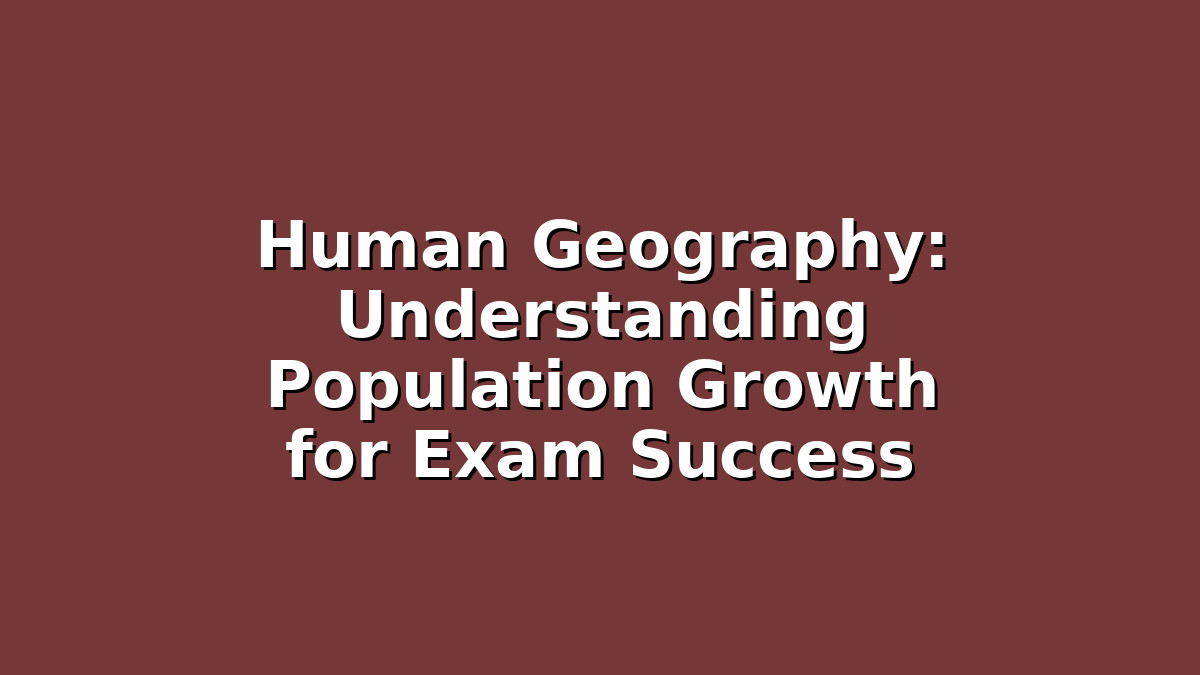Preparing for your human geography exams can sometimes feel overwhelming, especially when tackling complex topics like population growth. But don’t worry! With the right approach and study strategies, you can master this essential concept and boost your confidence. This article will guide you through the key aspects of population growth in human geography, offer practical study tips, and help you prepare effectively for your exams.
Introduction: Why Population Growth Matters in Human Geography
Population growth is a fundamental topic in human geography because it directly influences how societies develop, how resources are allocated, and how environments change. Understanding the patterns, causes, and effects of population growth can help you analyze human interactions with space and place. Whether your syllabus focuses on demographic transition models, population policies, or impacts on urbanization and resources, grasping these concepts is crucial.
As a student preparing for exams, it’s important not only to memorize facts but also to engage critically with the material. This helps you answer both straightforward and application-based questions effectively. Let’s explore three key sections: understanding population growth concepts, applying case studies, and effective revision techniques.
—
1. Grasping the Key Concepts of Population Growth
Before diving into exam questions, start by building a solid foundation. Population growth encompasses several important concepts that you need to understand thoroughly:
– Population Size and Growth Rate: Know how to calculate and interpret growth rates, including natural increase (birth rate minus death rate) and net migration. These numbers help explain why populations expand or contract.
– Demographic Transition Model (DTM): This model outlines the changes in population growth over time through different stages, from high birth and death rates to low rates in developed countries. Be sure you can explain each stage and give examples.
– Factors Influencing Population Growth: Study the causes of growth such as fertility rates, mortality rates, migration, government policies, and socio-economic factors.
– Population Structures: Learn about age-sex pyramids and what they reveal about a country’s population dynamics.
– Population Policies: Understand how different countries manage population growth through pro-natalist or anti-natalist policies.
Study Tip: Create summary notes or flashcards for each concept, including definitions, diagrams (like the DTM), and key statistics. Visual aids are especially helpful in memorizing models and recognizing patterns quickly during exams.
—
2. Using Case Studies to Make Population Growth Real
Human geography exams often require you to apply your knowledge to real-world examples. Case studies help bring theory to life and demonstrate your understanding of population growth’s diverse impacts.
– Choose Relevant Case Studies: Pick a mix of countries at different stages of population growth—such as Nigeria (rapid growth), Japan (population decline), and China (population policy impact).
– Focus on Causes and Consequences: For each case, outline why population growth is occurring or slowing, and what effects it has on urban development, resource use, employment, health, and the environment.
– Link to Concepts: Connect your case study examples back to the DTM, migration trends, or government policies. This shows examiners you understand the wider significance.
– Practice Writing Answers: Write short paragraphs explaining each case study, using data where possible. This will improve your ability to include examples confidently in your exam essays.
Study Tip: Create a case study folder or digital document where you summarize key facts, causes, effects, and policy responses for each example. Use bullet points for clarity and quick revision.
—
3. Effective Revision Techniques for Population Growth
Understanding content is only half the battle; effective revision is key to exam success. Here are some study strategies tailored to population growth topics:
– Active Recall & Spaced Repetition: Test yourself regularly on population growth definitions, models, and case studies. Use apps like Quizlet or make your own flashcards.
– Practice Past Exam Questions: Look for questions on population growth from previous years or sample papers. Practice writing clear, structured answers within a time limit.
– Mind Maps and Diagrams: Create mind maps linking population growth causes, effects, and policies. Visualizing connections helps deepen your understanding.
– Group Study: Discuss population growth topics with classmates. Teaching concepts to others reinforces your learning and exposes you to different perspectives.
– Use Online Resources: Supplement your textbooks with videos, interactive quizzes, and articles that explain population growth in engaging ways.
Study Tip: Set a revision timetable that breaks down topics into manageable chunks and includes regular breaks. Consistency beats cramming when preparing for exams.
—
Conclusion: Stay Positive and Keep Practicing
Human geography’s population growth topic is rich with interesting concepts and real-world relevance. By understanding key ideas, using case studies effectively, and adopting smart revision techniques, you’ll be well-prepared for your exams.
Remember, learning is a journey—don’t get discouraged if you find some concepts tricky at first. Keep practicing, use a variety of study methods, and ask your teachers or peers for help when needed. With persistence and the right strategies, mastering population growth is entirely within your reach.
Good luck with your studies, and don’t forget to stay curious—human geography offers fascinating insights into the world we live in!

Responses